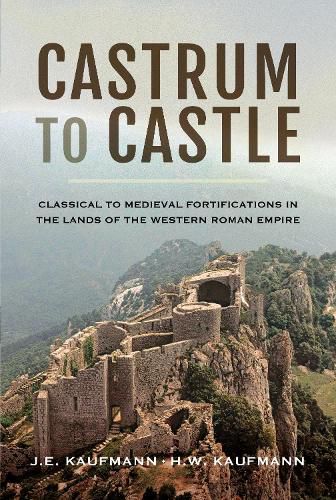Readings Newsletter
Become a Readings Member to make your shopping experience even easier.
Sign in or sign up for free!
You’re not far away from qualifying for FREE standard shipping within Australia
You’ve qualified for FREE standard shipping within Australia
The cart is loading…






For over a thousand years, from the time of the Roman Empire to the classic period of castle-building in the twelfth and thirteenth centuries, fortified sites played a key role in European warfare. This highly illustrated history gives a fascinating insight into their design and development and into the centuries of violence and conflict they were part of. The study traces the evolution of fortifications starting with those of the Romans and their successors. Included are the defences erected to resist Islamic invasions and Viking raids and the castles that were built during outbreaks of warfare. As the authors demonstrate, castles and other fortifications were essential factors in military calculations and campaigns - they were of direct strategic and tactical importance wherever there was an attempt to take or hold territory. The factors that influenced their location, layout and construction are analysed, as is the way in which they were adapted to meet the challenges of new tactics and weapons. AUTHORS: J.E. Kaufmann is a retired teacher and presently an adjunct professor at Palo Alto Jr. College and H.W. Kaufmann, PhD, is a retired professor, and they live in the United States. Their most recent books on fortifications are The Maginot Line, The Atlantic Wall, The Forts and Fortifications of Europe 1815-1945: The Central States, The Forts and Fortifications of Europe 1815-1945: The Neutral States and Verdun 1916: The Renaissance of the Fortress.
100 colour and b/w illustrations
$9.00 standard shipping within Australia
FREE standard shipping within Australia for orders over $100.00
Express & International shipping calculated at checkout
For over a thousand years, from the time of the Roman Empire to the classic period of castle-building in the twelfth and thirteenth centuries, fortified sites played a key role in European warfare. This highly illustrated history gives a fascinating insight into their design and development and into the centuries of violence and conflict they were part of. The study traces the evolution of fortifications starting with those of the Romans and their successors. Included are the defences erected to resist Islamic invasions and Viking raids and the castles that were built during outbreaks of warfare. As the authors demonstrate, castles and other fortifications were essential factors in military calculations and campaigns - they were of direct strategic and tactical importance wherever there was an attempt to take or hold territory. The factors that influenced their location, layout and construction are analysed, as is the way in which they were adapted to meet the challenges of new tactics and weapons. AUTHORS: J.E. Kaufmann is a retired teacher and presently an adjunct professor at Palo Alto Jr. College and H.W. Kaufmann, PhD, is a retired professor, and they live in the United States. Their most recent books on fortifications are The Maginot Line, The Atlantic Wall, The Forts and Fortifications of Europe 1815-1945: The Central States, The Forts and Fortifications of Europe 1815-1945: The Neutral States and Verdun 1916: The Renaissance of the Fortress.
100 colour and b/w illustrations